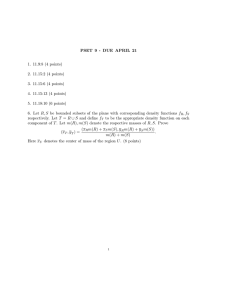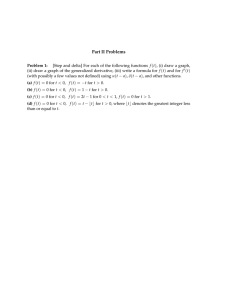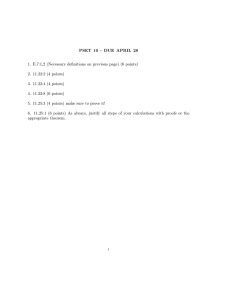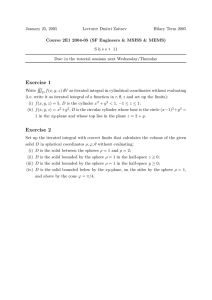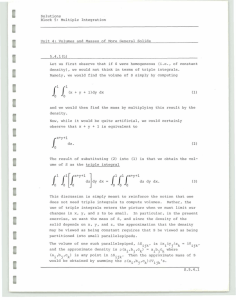Document 13650797
advertisement
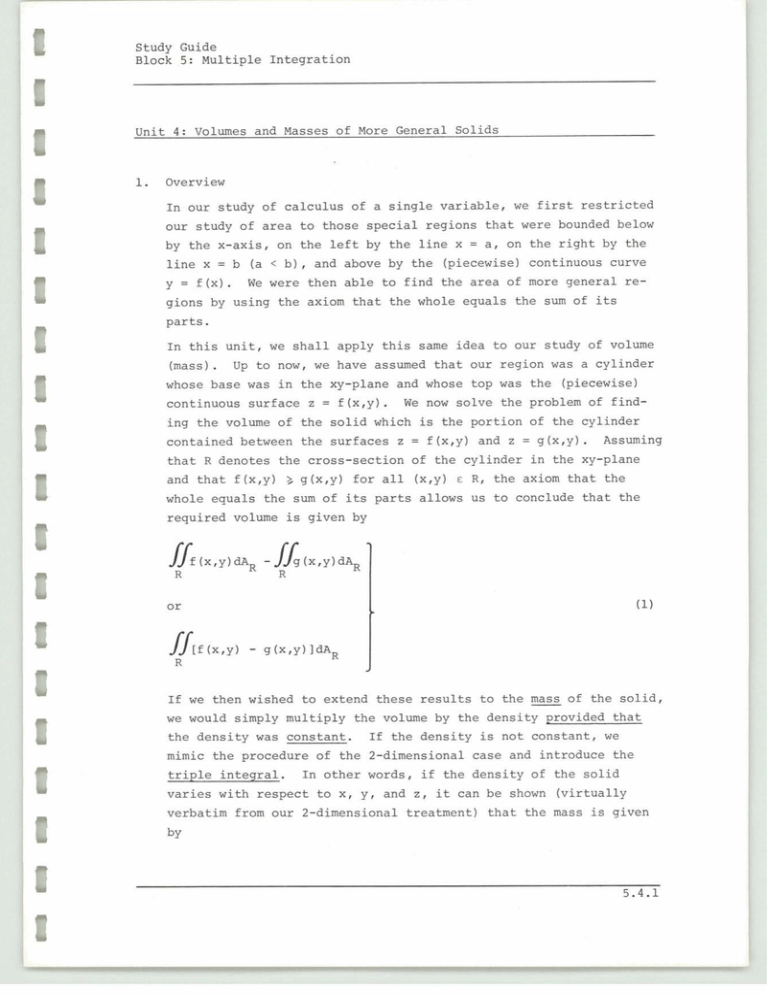
Study Guide Block 5: Multiple Integration Unit 4: Volumes and Masses of More General Solids Overview In our study of calculus of a single variable, we first restricted our study of area to those special regions that were bounded below by the x-axis, on the left by the line x = a, on the right by the line x = b (a < b), and above by the (piecewise) continuous curve y = f(x). We were then able to find the area of more general regions by using the axiom that the whole equals the sum of its parts. In this unit, we shall apply this same idea to our study of volume (mass). Up to now, we have assumed that our region was a cylinder whose base was in the xy-plane and whose top was the (piecewise) continuous surface z = f(x,y). We now solve the problem of finding the volume of the solid which is the portion of the cylinder contained between the surfaces z = f(x,y) and z = g(x,y). Assuming that R denotes the cross-section of the cylinder in the xy-plane and that f (x,y) g(x,y) for all (x,y) E R, the axiom that the whole equals the sum of its parts allows us to conclude that the required volume is given by If we then wished to extend these results to the mass of the solid, we would simply multiply the volume by the density provided that the density was constant. If the density is not constant, we mimic the procedure of the 2-dimensional case and introduce the triple integral. In other words, if the density of the solid varies with respect to x, y, and z , it can be shown (virtually verbatim from our 2-dimensional treatment) that the mass is given by Study Guide Block 5: Multiple Integration Unit 4: Volumes and Masses of More General Solids where p(x,y,z) denotes the density of the solid and S denotes the solid. * It is important to notice that just as we used double integration to find mass rather than to find area (i.e., for area the old /a b "recipe" f (x)dx was still adequate); we use triple integrals to find masses of certain types of solids. For finding volumes, the recipe given by equation (1) suffices. 2. Read Thomas, Section 16.5. 3. Exercises : 5.4.1(L) The solid S is the cylinder whose base is the square with vertices at (0,0), (0,1), (1,1), and (1,O) in the xy-plane and whose top is the plane z = x + y + 1. The density of this solid is given by p(x,y,z) = xyz at each point (x,y,z) E S. Find the mass of S. Let R be the region in the xy-plane bounded between the y-axis, the curve y = x2, and the line y = 4. Let C be the cylinder whose base is R. Find the volume of S if S is the portion of C contained between the two surfaces z = x 2 + y2 + 3 and z = x + y + 1. 5.4.3 With C as in the previous exercise, let S be that portion of C 2 contained between the xy-plane and the surface z = x + y2 + 3. Find the mass of S if its density at any point (x,y,z) is xyz. * T h i s w i l l b e e x p l a i n e d i n more d e t a i l i n t h e s o l u t i o n s o f t h e exercises i n this unit. Study Guide Block 5: M u l t i p l e I n t e g r a t i o n U n i t 4 : Volumes and Masses of More General S o l i d s Find t h e volume of t h e r e s i o n bounded between t h e two s u r f a c e s Find t h e volume o f S i f S i s t h e r e g i o n bounded above by x 2 + y2 + z2 = 4 and below by 6 z = x 2 + y 2 . Find t h e volume bounded between t h e e l l i p t i c p a r a b o l o i d s 2 2 z = x2 + 9y2 and z = 18 - x 9y - . Find t h e volume of t h e r e g i o n common t o t h e two c i r c u l a r c y l i n d e r s 2 2 2 + y 2 = a 2 a n d x 2 + z = a . x MIT OpenCourseWare http://ocw.mit.edu Resource: Calculus Revisited: Multivariable Calculus Prof. Herbert Gross The following may not correspond to a particular course on MIT OpenCourseWare, but has been provided by the author as an individual learning resource. For information about citing these materials or our Terms of Use, visit: http://ocw.mit.edu/terms.
